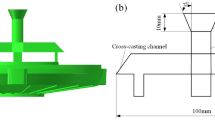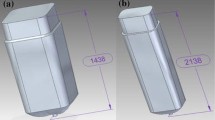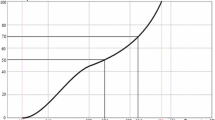Abstract
The influence and signification of casting parameters on the solidification process of steel ingot were discussed based on the finite element method (FEM) results by orthogonal experiment method. The range analysis, analysis of variance (ANOVA) and optimization project were used to investigate the FEM results. In order to decrease the ingot riser head and improve the utilization ratio of ingot, the casting parameters involved casting temperature, pouring velocity and interface heat transfer were optimized to decrease shrinkage pore and microporosity. The results show that the heat transfer coefficient between melt and heated board is a more sensitive factor. It is favor to decrease the shrinkage pore and microporosity under the conditions of low temperature, high pouring velocity and high heat transfer between melt and mold. If heat transfer in the ingot body is quicker than that in the riser, the position of shrinkage pore and microporosity will be closer to riser top. The results of optimization project show that few of shrinkage pore and microporosity reach into ingot body with the rational parameters, so the riser size can be reduced.
Similar content being viewed by others
References
GUO Hui-guang, QU Zong-shi. Development of heavy forging manufacturing industry in our country[J]. Heavy Casting and Forging, 2003, 25(1): 42–45. (in Chinese)
GU J P, BECKERMANN C. Simulation of convection and macrosegregation in a large steel ingot[J]. Metallurgical and Materials Transactions A, 1999, 30(5): 1357–1366.
LU Y, BECKERMANN C, RAMIREZ J C. Three-dimensional phase-field simulations of the effect of convection on free dendritic growth[J]. Journal of Crystal Growth, 2005, 280(1/2): 320–334.
RERKO R S, de GROH III H C, BECKERMANN C. Effect of melt convection and solid transport on macrosegregation and grain structure in equiaxed Al-Cu alloys[J]. Materials Science and Engineering A, 2003, 347(1/2): 186–197.
AROLA R, WENDT J, KIVINEVA E. Gas porosity defects in duplex stainless steel castings[J]. Materials Science Forum, 1999, 319(5): 297–302.
LEHMANN J, ROCABOIS P, GAYE H. Kinetic model of non-metallic inclusions precipitation during steel solidification[J]. Journal of Non-Crystalline Solids, 2001, 282(1): 61–71.
XUE Xiang, LI Hong-wei. Influence of pressure on shrinkage porosity prediction[J]. Transactions of Nonferrous Metals Society of China, 2005, 15(2): 217–221. (in Chinese)
SHAFYEI A, ANIJDAN S H, MOUSAVI, BAHRAMI A. Prediction of porosity percent in Al-Si casting alloys using ANN[J]. Materials Science and Engineering A, 2006, 431(1/2): 206–210.
ZHANG Xian-fu. The influence of casting temperature and velocity on the slag deposition of ingot head[J]. Journal of Hebei Institute of Technology, 2001, 23(2): 1–5. (in Chinese)
LI Qiang, DU Qiang, LI Dian-zhong. Shrinkage prediction during the heavy casting roller solidification[J]. Foundry, 2002, 51(5): 297–300. (in Chinese)
ZHANG Xiang-kun, SHI Wei, GAO Guo-feng. Numerical simulation of temperature field of hollow ingot solidification and prediction of shrinkage cavity and porosity[J]. Foundry, 2000, 149(16): 344–349. (in Chinese)
RADOVIC Z, LALOVIC M. Numerical simulation of steel ingot solidification process[J]. Journal of Materials Processing Technology, 2005, 160(2): 156–159.
HOU Hua, CHENG Jun, XU Hong. Development of CAD software package of intellectualized casting technology[J]. Journal of Central South University of Technology, 2005, 12(3): 280–283. (in Chinese)
LI Yu-yan, HU Chuan-rong. Test design and data processing[M]. Beijing: Chemical Industry Press, 2005. (in Chinese)
DU Xin-kang, WANG Jian-jiang, WANG Tian-min, LIU Hong-wei, LI Wei-bo. Orthogonal experiment and microstructure analysis on TiC-TiB2 multi-phase ceramic coating prepared by SHS reactive spraying[J]. Transactions of Nonferrous Metals Society of China, 2007, 17(1): 847–850. (in Chinese)
GUO Li, MA Dong-xia, WU Ai-xiang. Sensitivity analysis of rock mass mechanics parameters by orthogonal finite-element approach[J]. Journal of Central South University of Technology, 2004, 35(1): 138–141. (in Chinese)
Author information
Authors and Affiliations
Corresponding author
Additional information
Foundation item: Projects(50435010; 50705080; 50675187) supported by the National Natural Science Foundation of China
Rights and permissions
About this article
Cite this article
Zhang, P., Li, Xt., Zang, Xl. et al. Optimizing casting parameters of steel ingot based on orthogonal method. J. Cent. South Univ. Technol. 15 (Suppl 2), 296–300 (2008). https://doi.org/10.1007/s11771-008-0475-z
Received:
Accepted:
Published:
Issue Date:
DOI: https://doi.org/10.1007/s11771-008-0475-z




